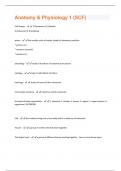Exam (elaborations)
Anatomy & Physiology 1 (SCF) Questions and answers
- Course
- Institution
Cell Shapes - 1) Squamous 2) Cuboidal 3) Columnar 4) Transitional atoms - the smalles units of matter (made of subatomic particles- * protons (+) * neutrons (neutral) * electrons (-) physiology - study of functions of anatomical structures cytology - study of cells &their functions histolog...
[Show more]



